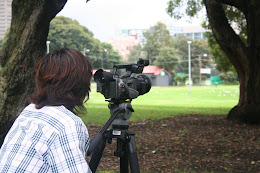The Universal Definition of Political Cartoon
1. Introduction
People and politics could be defined in economic terms of demand and supply or cause and effect. Politics obtain the powers that control national organisations by the people who want to develop their ground of lives. The public want to appear their opinion about politics. Politics comment on a variety of methods, such as music, movie, speeches, and cartoons. Political cartooning is one of the ways to convey the public's desire. However, political cartoons may be a sensitive issue, because it depends on situation of cartoonists and agreement by the public. The aim of this report is to examine the key a universal definition associated with the term political cartoon, also describe reasons and examples about the definition.
2. Discussion of Political Cartoon
2.1 Composition
Political cartoons are different from general cartoons. Typically, political cartoons are composed of two aspects, which are caricature and allusion. According to Backer (1996, para. 1), caricature is individual parodies and allusion is creations of the situation or context of the placement of the individual. These aspects are shown by simple illustration and short sentences usually to express strongly. Backer (1996, para. 1) also defines that political cartoons were the "fanciful exercises" in the past. It could be before did not appear the power of the political cartoons.
In
2.3 Influence
One political cartoon has often strong powers, which show and move the public's desire. An illustration of this is "Join or Die" by Benjamin Franklin. Disconnected snake with abbreviated words represented the Colonies. This was the first American political cartoon; also it became the symbol of the American Revolution. Backer (1996, para. 5) states that "
3. Definition of Political Cartoon
3.1 Definition
Political cartoon define the visual aspects, discourse, and arguing without the need to read. One of these examples is Luther's cartoon, "Passional Christi und Antichristi" which was originally drawn by Lucas Cranach, with simple illustration and no writing. It may be for the people who could not read, and became more Christlike (Backer 1996, para. 3). Another of these examples is Steve Bell's cartoon in 1997, British. This cartoon figured one man, who wears the cellular underpants outside his trousers and is ready to fire his wick, with the title, "Election 97". In this example, "Major appears to hope the pants will act as a sort of rocket launcher, jetting him into the general election campaign" (Seymour-Ure 2001, p. 350).
3.2 Reasons
The public want to know hidden truths. Also, they want to change or turn to the right direction. These describe why political cartoons are continued within history. The author, Seymour-Ure (2001) describes continuity among cartoonists. "This combination of familiarity and predictability with a particular freshness every day is what provides a newspaper with its stability as an enterprise" (p. 337). Flows of stories in political cartoons are attractive because it seems like separated story or not connected. However, it is not comics. This means for reading or recognising political cartoons, readers should know the background of each cartoon. That is why cartoonists have expressed instead of the public by independent way.
3.3 Examples
Some of political cartoons influenced salient events of history. "Join or Die" by Benjamin Franklin became the symbol of the American Revolution, it responded the Civil War. "Mr.
4. Conclusion
Political cartoons could be defined universally because countries that have politics and no limit of expression have political cartoons. This history is long term because it is the public's desire and expression of opinions. Even though politicians do not want to be treated by cartoon, it is significant way to develop "human social".
References
Backer, D. 1996, 'A Brief History of Political Cartoon', Uniting Mugwumps and the Masses, viewed 11 September 2007, <
Seymour-Ure, C. 2001, 'What Future for the British Political Cartoon?', Journalism Studies, vol. 2, no. 3, pp. 333-355.
Tju, L.C. 2001, 'Political Cartoons in Singapore: Misnomer or Redefinition Necessary?', Journal of Popular Culture, pp. 77-83.



